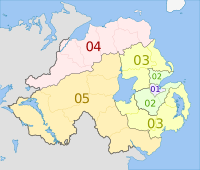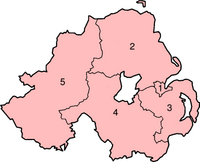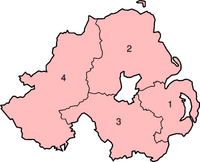Local government in Northern Ireland facts for kids
Northern Ireland is divided into 11 districts for local government purposes. In Northern Ireland, local councils do not carry out the same range of functions as those in the rest of the United Kingdom; for example they have no responsibility for education, road-building or housing (although they do nominate members to the advisory Northern Ireland Housing Council). Their functions include waste and recycling services, leisure and community services, building control and local economic and cultural development. They are not planning authorities, but are consulted on some planning applications. The collection of rates is handled by the Land and Property Services agency.
Contents
History
The current pattern of 11 local government districts was established on 1 April 2015, as a result of the reform process that started in 2005.
The previous pattern of local government in Northern Ireland, with 26 councils, was established in 1973 by the Local Government (Boundaries) Act (Northern Ireland) 1971 and the Local Government Act (Northern Ireland) 1972 to replace the previous system established by the Local Government (Ireland) Act 1898. The system was based on the recommendations of the Macrory Report, of June 1970, which presupposed the continued existence of the Government of Northern Ireland to act as a regional-level authority.
From 1921 to 1973, Northern Ireland was divided into six administrative counties (subdivided into urban and rural districts) and two county boroughs. The counties and county boroughs continue to exist for the purposes of lieutenancy and shrievalty. This system, with the abolition of rural districts, remains the model for local government in the Republic of Ireland. (See also List of rural and urban districts in Northern Ireland for more details.)
Elections
Councillors are elected for a four-year term of office under the single transferable vote (STV) system. Elections were last held in May 2014. To qualify for election, a councillor candidate must be:
- at least 18 years of age, and
- a Commonwealth of Nations or European Union citizen.
In addition, he or she must either:
- be a local elector for the district, or
- have, during the whole of the 12-month period prior to the election, either owned or occupied land in the district, or else resided or worked in the district.
Combinations
The districts are combined for various purposes.
Eurostat NUTS level 3
In the Eurostat Nomenclature of Territorial Units for Statistics (NUTS), Northern Ireland is divided into five parts at level 3
Former Education and Library Boards
There were five education and library boards (ELBs) in Northern Ireland.
As part of the Review of Public Administration process, the library functions of the ELBs were taken over by a new body, the Northern Ireland Library Authority (branded Libraries NI) in April 2009.
The education and skills functions were centralised into a single Education Authority for Northern Ireland in April 2015.
The boards were as follows:
Former Health and Social Services Boards
There were four health and social services boards which were replaced by a single Health and Social Care Board in April 2009.
The former health and social services boards were as follows:
Reform
In June 2002, the Northern Ireland Executive established a Review of Public Administration to review the arrangements for the accountability, development, administration and delivery of public services. Among its recommendations were a reduction in the number of districts. In 2005 Peter Hain, the Secretary of State for Northern Ireland, announced proposals to reduce the number of councils to seven. The names and boundaries of the seven districts were announced in March 2007. In March 2008 the restored Northern Executive agreed to create eleven new councils instead of the original seven. The first elections were due to take place in May 2011. However, by May 2010 disagreements among parties in the executive over district boundaries were expected to delay the reforms until 2015. In June 2010 the proposed reforms were abandoned following the failure of the Northern Ireland Executive to reach agreement. However, on 12 March 2012, the Northern Ireland Executive published its programme for government, which included a commitment to reduce the number of councils in Northern Ireland to 11.
See also
 In Spanish: Organización territorial de Irlanda del Norte para niños
In Spanish: Organización territorial de Irlanda del Norte para niños




